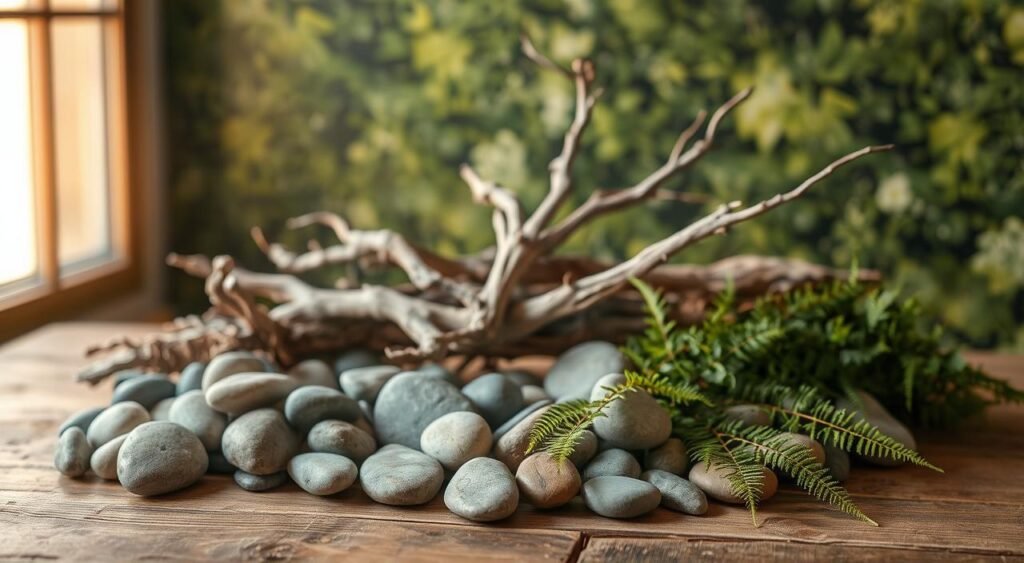Ever ponder how a few plants or a woven basket could transform your home into a serene sanctuary? Decorating with natural materials is more than a fleeting trend—it’s a path to infusing your living space with the essence of nature. This approach combines the organic textures and hues of the outdoors with the clean lines of modern design. It’s not just about aesthetics; it’s a choice that’s both soothing and sustainable.
Did you know that 40% of homeowners now seek out sustainable materials like bamboo or reclaimed wood? Organic modern interior design shows that embracing eco-friendly options can elevate your space without breaking the bank.
Key Takeaways
- Organic decor ideas use natural materials like wood, stone, and plants to create warmth and serenity.
- Choosing earthy tones and natural light maximizes the calming effect of organic spaces.
- Reclaimed wood and bamboo offer durability while reducing environmental impact.
- Indoor plants improve air quality and mood with minimal effort.
- Sustainable practices like energy-efficient lighting blend practicality with aesthetic appeal.
Embracing the Essence of Natural Home Design
Imagine a space where clean lines meet the warmth of a forest or where sunlight dances on stone walls. This is the essence of biophilic home decor. It’s a style that merges modern living with nature’s rhythms. It’s more than a trend; it’s a response to our need for calm in a fast-paced world. Let’s explore how this philosophy shapes homes today.
The Resurgence of Nature in Modern Interiors
Think of interiors where nature-inspired design meets sleek contemporary layouts. Green walls, stone accents, and wood textures are more than decor—they’re a return to basics. This shift reflects a global trend toward eco-conscious living, blending sustainability with style. Picture a minimalist sofa next to a living moss wall or a concrete planter with trailing ivy. It’s about finding balance.
How Biophilic Design Enhances Well-being
Studies show spaces with plants boost focus by 15%—proof that biophilic home decor is both pretty and practical. Natural light, earthy tones like sage greens and terracotta, and even water features like tabletop fountains reduce stress. These elements don’t just look good—they help you breathe better. Try a fiddle leaf fig in your office or a woven jute rug to ground a room.
Finding Balance Between Contemporary and Organic Styles
Want that modern-meets-nature vibe? Start small. Pair a glass coffee table with a chunky wooden sideboard. Hang abstract art inspired by tree bark. Use soft wool throws on metal-frame sofas. The key? Let organic textures—like woven rattan chairs or river stone decor—soften sharp angles. Mix and match until it feels alive.
The Psychological and Physical Benefits of Organic Decor
Ever wondered why a room with plants or natural textures feels so inviting? Let’s explore how eco-friendly interior design turns spaces into havens for both mind and body. Science reveals that biophilic elements like wood, stone, and greenery are more than trends—they’re mood-boosters!
Imagine this: a study found that simply viewing natural patterns, like the grain in a reclaimed table, can lower stress hormones. Plants don’t just clean the air—they also reduce mental fatigue by 61%, according to a 2023 Harvard study. That’s why I suggest green living decorations like snake plants or fiddle-leaf figs—they’re your quiet allies against anxiety!
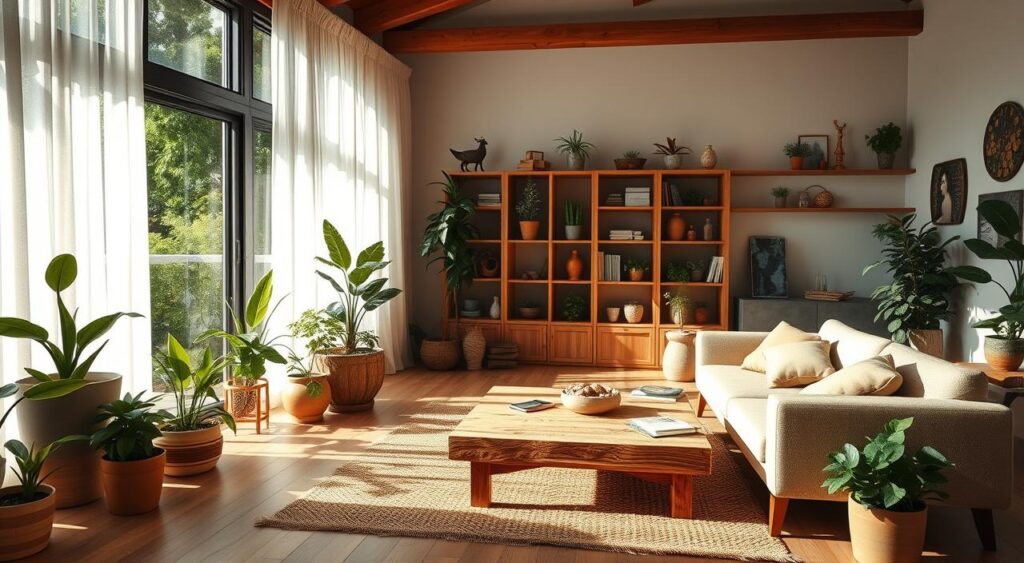
- Stress Relief: Indoor plants release oxygen and absorb toxins, creating a calmer environment.
- Improved Sleep: Earthy tones (think greens and browns) signal the brain to unwind, perfect for bedrooms.
- Focus Boost: Natural light and wood accents increase concentration—ideal for home offices!
| Element | Impact |
|---|---|
| Indoor plants | Reduce stress hormones by 25% |
| Wood textures | Lower blood pressure and heart rate |
| Natural light | Enhance mood via vitamin D synthesis |
Ready to transform your space? Even small changes—like swapping synthetic fabrics for linen curtains or adding a stone accent—can make a big difference. Let’s turn your home into a sanctuary that nourishes your well-being, one organic piece at a time. 🌿
Decorating with Natural Materials: Principles and Practices
Ready to transform your space with nature-inspired style? Let’s explore the essentials of sustainable home decor that blend timeless charm with modern flair. These tips will guide you in merging ethical choices with your personal style.
Understanding Material Sustainability
Begin by selecting materials that benefit the environment. Opt for reclaimed wood, recycled glass, or mycelium leather for eco-friendly options. Ensure suppliers have certifications like SFC or GOTS to avoid misleading claims. For affordable options, explore local markets.
- Bamboo: A renewable, durable choice for furniture or decor
- Recycled glass: Transforms old jars into kitchen counters or accents
- Mycelium leather: A fungi-based alternative to traditional leather
Color Palettes Inspired by Nature
Consider muted greens, soft grays, and earthy neutrals. Introduce bold accents like terracotta or deep blues to add vibrancy without overwhelming. These colors foster a calming atmosphere, complementing any room’s theme.
Textural Considerations for Balanced Spaces
Introduce textures like woven baskets, wooden shelves, and linen textiles to prevent flatness. Combine rough and smooth surfaces, such as a jute rug with a smooth stone vase, for visual balance.
Integrating Natural Elements with Existing Decor
Begin with small changes. Add a potted plant to your desk or replace synthetic throw pillows with organic cotton ones. Thrift stores and local markets are great for vintage finds. For eco-friendly rugs and textiles, consider brands like Lorena Canals and Quince.
Every decision matters. By focusing on natural materials and thoughtful layering, you’ll craft a sanctuary that’s both stylish and eco-conscious. Are you ready to embark on this journey?
Wood Elements: Bringing Warmth and Character to Any Space
Wood bridges the gap between nature and interior design, from weathered barnwood to sleek live-edge slabs. It can even be a driftwood sculpture with a story. Whether you seek rustic home accents or eco-conscious design, wood brings endless possibilities to infuse your space with soul.
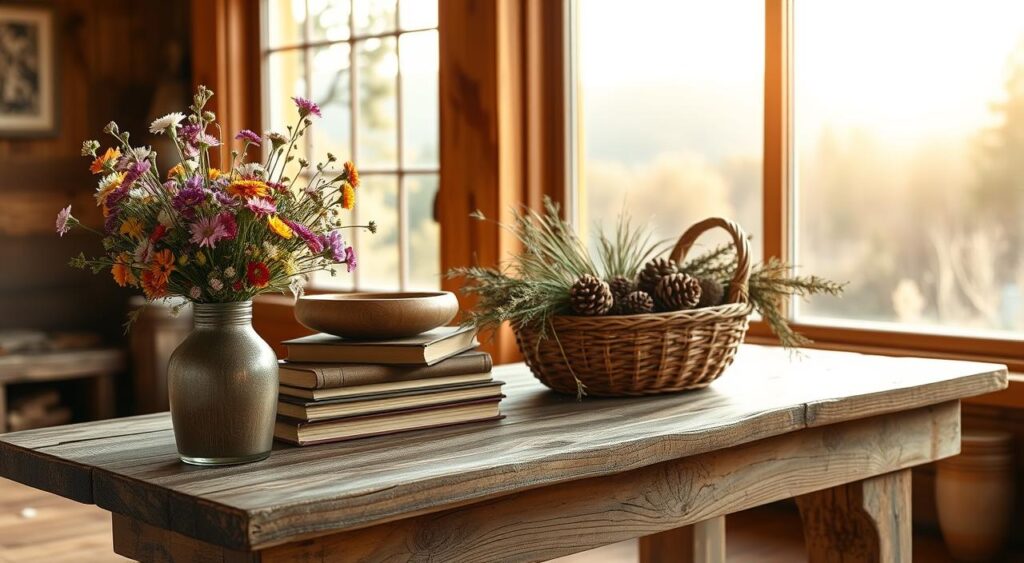
reclaimed wood features for sustainable style>
- Repurpose old shipping pallets into a farmhouse-style coffee table.
- Hang a reclaimed wood gallery wall to display cherished memories.
- Swap out sleek countertops for a salvaged wood butcher block for instant rustic charm.
Stores like Flooring America now offer reclaimed wood flooring. It’s sustainable and chic, aligning with eco-conscious design trends.
incorporating driftwood and natural timber>
“A driftwood mantel or a live-edge dining table creates conversation without costing your budget,” says interior designer Clara Nguyen.
Driftwood branches can be used as candleholders or grouped in a glass vase for a coastal look. For a bold statement, a natural timber headboard adds organic elegance to bedrooms.
wooden accents for minimal commitment>
| Item | Use | Why It Works |
|---|---|---|
| Mango wood trays | Entryway console displays | Adds texture without overwhelming small spaces |
| Wooden salad bowls | Open kitchen shelving | Functional decor that honors eco-conscious design |
| Carved coasters | Table accents | Perfect rustic home accents for renters or renters-to buyers |
A small wooden stool by the hearth or a woven wicker basket on the porch brings nature indoors. You don’t need to redo your entire living room. Start small and let the warmth grow!
Stone and Mineral Accents That Ground Your Home
Adding stone to your space doesn’t need a full overhaul. Small touches can make a big difference. Try organic decor ideas like a stacked stone accent wall or a pebble-trimmed bathroom shelf. These choices bring earthy vibes without breaking the bank.
Consider these mineral marvels for instant impact:
- Clear Quartz: Display clusters on shelves or use slices as coasters.
- Pyrite: Hang clusters near windows to catch light like tiny sun-catchers.
- Amazonite: Cut tiles create serene kitchen backsplashes or bathroom accent walls.
| Gemstone | Best Use | Mood |
|---|---|---|
| Agate | Geode coffee tables or mosaic wall art | Ethereal calmness |
| Fluorite | Diffused-light window displays | Peaceful ambiance |
| Sodalite | Bathroom tile inlays or accent furniture | Coastal tranquility |
DIY fans will love this! Glue river rocks to create a fireplace surround, or paint smooth stones for a backsplash (see 15 easy DIYs here). Even small quartz clusters on a side table can change your space!
Using natural materials like stone can boost property value while saving 50-75% compared to manufactured options.
Combine stones with organic textiles for a layered look. Start small: place a pyrite cluster on your desk or line a windowsill with polished pebbles. These choices create a sanctuary that feels both modern and deeply rooted in nature’s beauty.
Plant Life: The Ultimate Living Decor
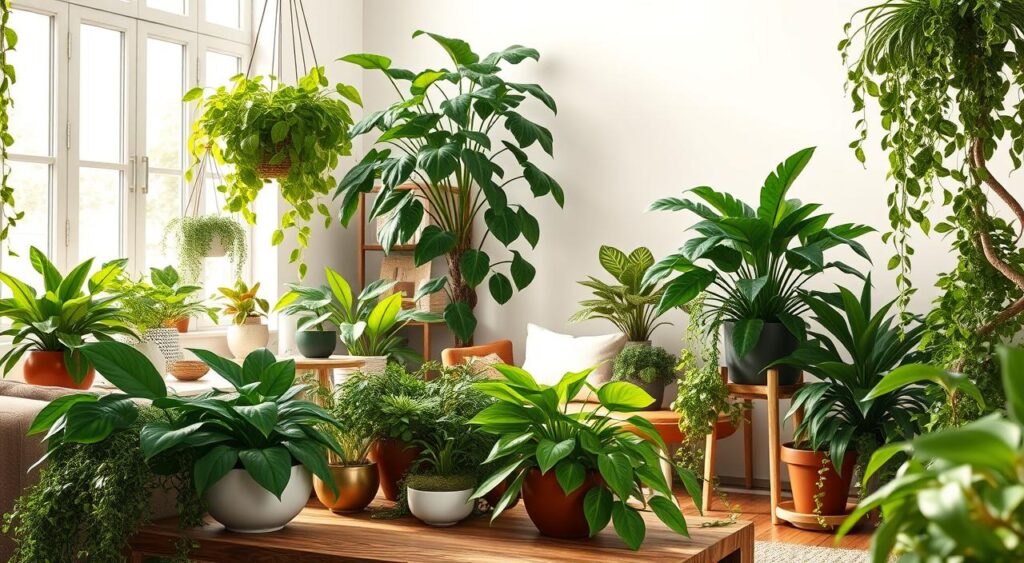
Plants are the heart of anynature-inspired design, infusing life into spaces effortlessly. They don’t need constant care. Whether you’re new to gardening or experienced, green living decorations turn homes into vibrant ecosystems. Let’s explore simple ways to make your space flourish, without the worry of forgotten watering.
Low-Maintenance Indoor Plants for Beginners
Begin with these easy-to-grow plants:
- Monstera—adds tropical flair to corners or shelves with filtered light.
- Succulents—group them in terracotta pots for a quick Southwest feel.
- Pothos
—trailing varieties are perfect for hanging planters.
Most houseplants do well with weekly watering and indirect light. Avoid overwatering, as it’s their biggest foe!
Creative Plant Display Solutions
Move beyond basic pots! Consider:
- Wall-mounted planters for tight spaces.
- Repurpose items: use stacked books to hold small succulents.
- Hanging terrariums (ensure they have enough air!).
Tip: Group plants to create a lush, curated look that echoes natural environments.
Preserved Plants and Flowers for Lasting Beauty
| Aspect | Live Plants | Preserved Options |
|---|---|---|
| Care | Weekly attention | Zero maintenance |
| Lifespan | Varies by species | 12+ months with proper handling |
| Style | Dynamic growth | Everlasting statement pieces |
Combine preserved eucalyptus or silk ferns in minimalist vases for a sleeknature-inspired design. Ideal for renters or areas with little sunlight.
Ready to enliven your space? Begin with a few plants, trust your instincts, and watch your home bloom. Your future self will appreciate the choice of embracing life itself!
Natural Textiles and Fibers for Comfort and Style
Ever wondered how to blend cozy textures with planet-friendly choices? eco-conscious design trends merge softness with Earth-friendliness. Natural fibers like cotton, wool, and jute can turn your home into a sustainable haven.
“Natural fibers are experiencing a resurgence in interior design due to their aesthetic appeal, functionality, and sustainability.”
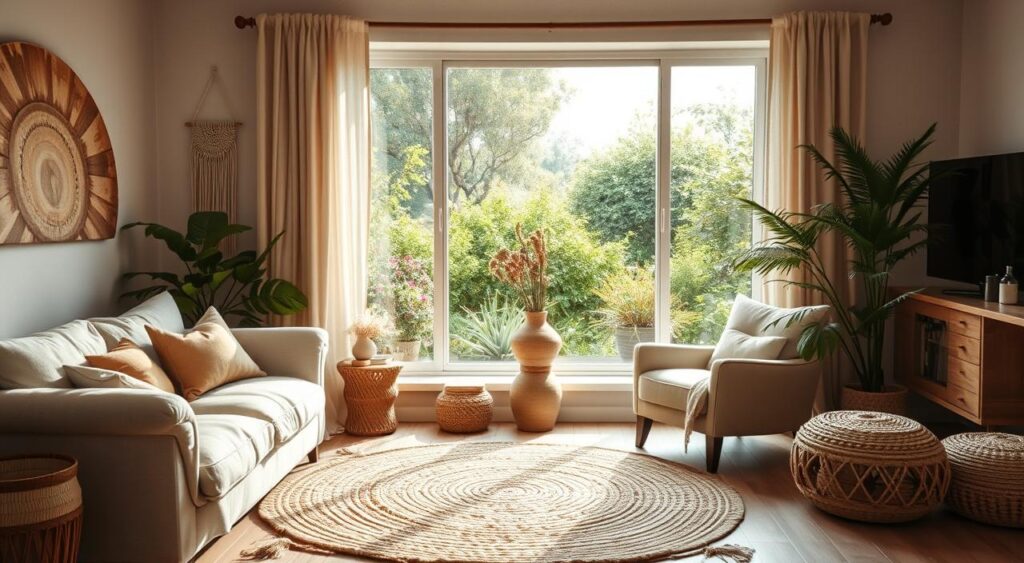
Cotton, Linen, and Hemp Applications
- Cotton: Soft and breathable, ideal for upholstery and bedding. Did you know cotton accounts for nearly 20% of global natural fiber production?
- Linen: Crisp and durable, perfect for summer drapes or table linens. Its rustic vibe adds instant biophilic touches without sacrificing comfort.
- Hemp: A game-changer for eco-warriors. Its antimicrobial properties make it ideal for upholstery and rugs that withstand daily wear.
Wool, Jute, and Sisal in Flooring and Accessories
For high-traffic areas, jute rugs and wool throws add warmth. Sisal blends with cotton create durable area rugs that fit modern or rustic styles. Think chunky-knit throws or braided mats for instant texture.
Incorporating Macramé and Woven Elements
Handwoven baskets or macramé plant hangers bring artisanal charm. Mix raw-edge linens with velvet throws to layer textures—no two spaces will ever look alike!
Ready to shop? Opt for organic cotton bedding or a handwoven jute tray. Every choice matters—your space will feel lush, and your conscience stays clear.
Water Features for Tranquility and Sensory Appeal
Introducing a water feature is a game-changer in biophilic home decor. Picture the calming sound of water in your living room or the serene sight of a tabletop fountain. Research indicates that spaces with water elements significantly enhance relaxation. For instance, biophilic hotel lobbies see a 36% increase in visitor dwell time!
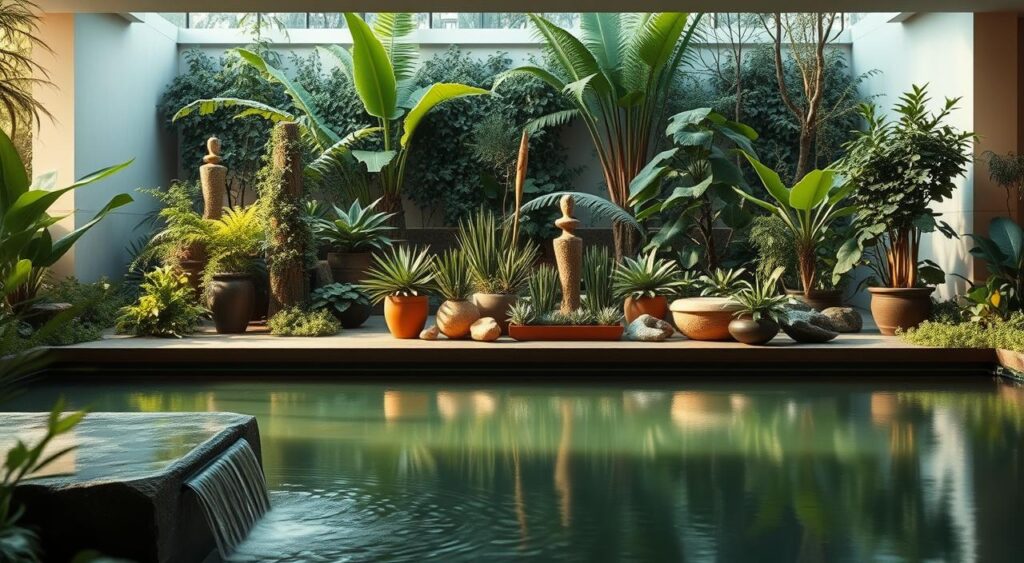
Now, let’s dive into organic decor ideas that bring water’s essence into your home:
- Mini indoor fountains: Ideal for desks or shelves.
- Self-contained tabletop ponds: Great for small areas with aquatic plants.
- LED-lit wall panels: Mimic flowing water with minimal upkeep.
- Reflective glass accents: Replicate water’s shimmer without the hassle.
A small bubbler or pebble garden with a misting system can be incredibly impactful. For a more subtle approach, consider mirrored surfaces or textiles with ripple patterns that mimic water’s movement. Pair these with natural elements like river rocks or moss to amplify the organic decor ideas effect.
Pro tip: Position water elements to catch light for stunning effects. Choose recirculating systems to save water—today’s pumps are quiet and energy-saving. Ready to create a sanctuary? Begin with a floating candle tray or a bamboo water feature. Every step towards a more natural environment is a step towards tranquility!
Seasonal Approaches to Eco-Conscious Decorating
Imagine a home that blooms with the seasons! Seasonal shifts are the perfect time to refresh your space using eco-conscious design trends that align with nature’s rhythms. No need to buy new every year—small swaps with organic materials keep your style fresh while honoring green living decorations. Let’s explore how to adapt your space sustainably without overhauling everything.
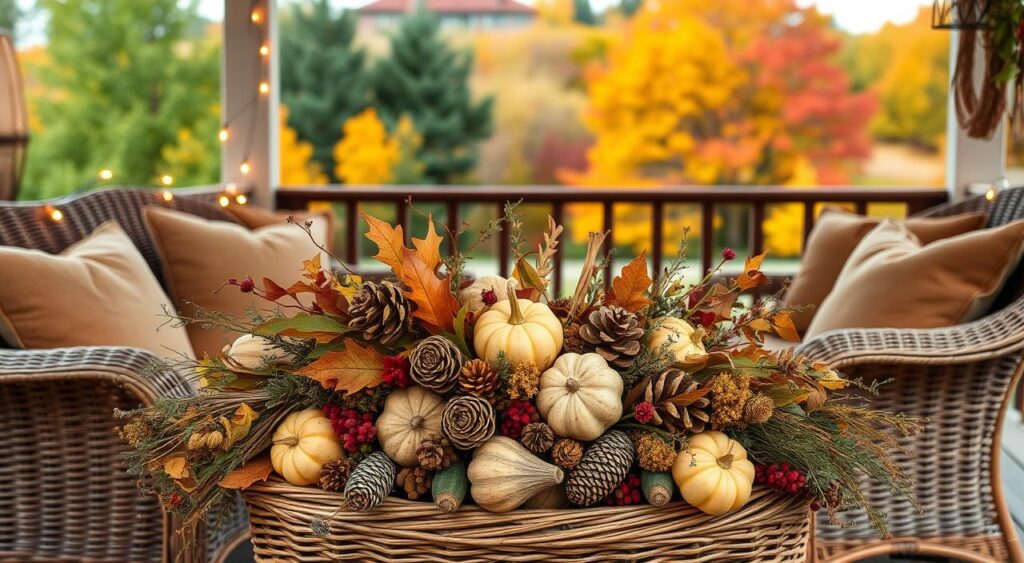
“The most beautiful aspect of natural decor is its ability to adapt with the seasons—transforming without tossing.”
Spring & Summer: Light and Renewal
Spring and summer call for airy textures and vibrant life. Try these ideas:
- Swap heavy throws for linen or organic cotton throws in soft pastels
- Bring in fresh floral arrangements—peonies, hydrangeas, or herbs like lavender
- Update decor with light wood accents like bamboo or reclaimed oak
- Paint walls with non-toxic paints in mint, buttercream, or sky blue
Autumn & Winter: Cozy Layers
As temperatures drop, layer in warmth without waste:
- Use dried flowers (pampas grass, eucalyptus) in FSC-certified wooden vases
- Embrace wool throws, jute rugs, and driftwood sculptures
- Hang evergreen garlands or cinnamon-scented orange slices for festive cheer
Transitions That Last
Keep decor evergreen (no pun intended!) with smart choices:
- Invest in neutral-toned vessels that work year-round
- Rotate plant collections—add fresh herbs in spring, swap to poinsettias in winter
- Repurpose holiday decor: turn autumn leaves into autumnal art, then use pinecones for winter wreaths
Seasonal decorating isn’t just about trends—it’s a way to celebrate nature’s cycles while keeping your home vibrant. What’s one small swap you’ll try this season?
Sourcing Ethical and Sustainable Natural Materials
Ever wonder where to start with sustainable home decor? Let me break it down. Choosing ethical materials isn’t just about aesthetics—it’s a promise to protect our planet. First, look for certifications that matter. FSC for wood, GOTS for textiles, and CertiPUR for foam ensure your choices align with eco-friendly interior design values.
“Forest Stewardship Council (FSC) certification means wood comes from responsibly managed forests.”
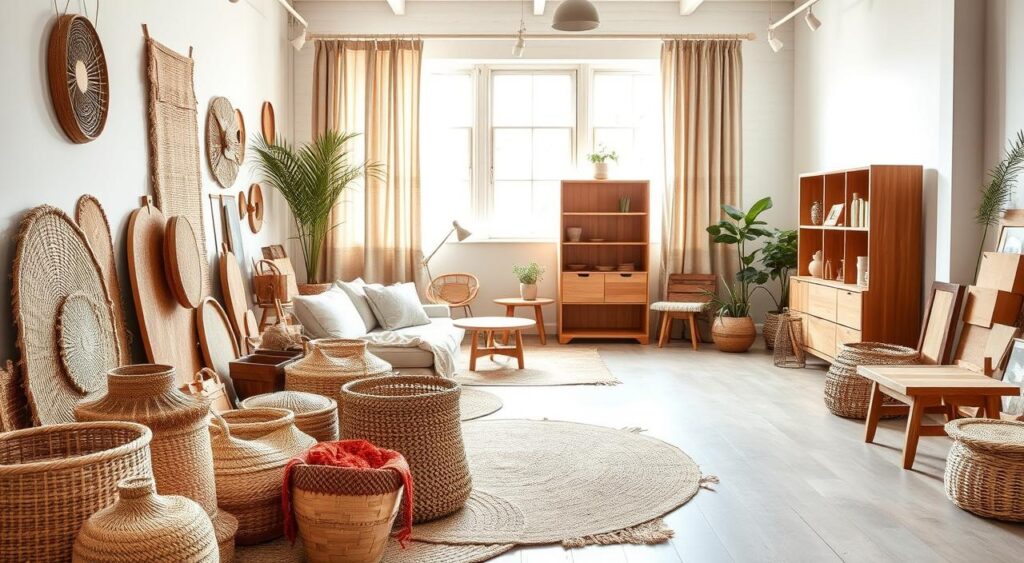
Start smart: opt for materials like bamboo, olive wood, or organic cotton. Avoid vinyl and flame-retardant-treated goods—they harm both health and the environment. Brands like Boll & Branch (organic linens) and Avocado Mattress (non-toluene mattresses) make it easy. Even small swaps count! Choose teak or acacia for outdoor furniture—they’re durable and sustainable.
- Check certifications before buying
- Prefer handcrafted items from fair-trade artisans
- Shop secondhand or visit local markets for unique finds
Don’t forget skin-contact items like bedding or upholstery—prioritize natural fibers like wool or linen. And hey, foraged materials like driftwood or dried flowers can add personal flair without costing the Earth. Every choice matters, whether you’re redoing a bedroom or updating a living room. Let’s build spaces that inspire while respecting our planet’s limits.
DIY Projects Using Foraged and Upcycled Organic Elements
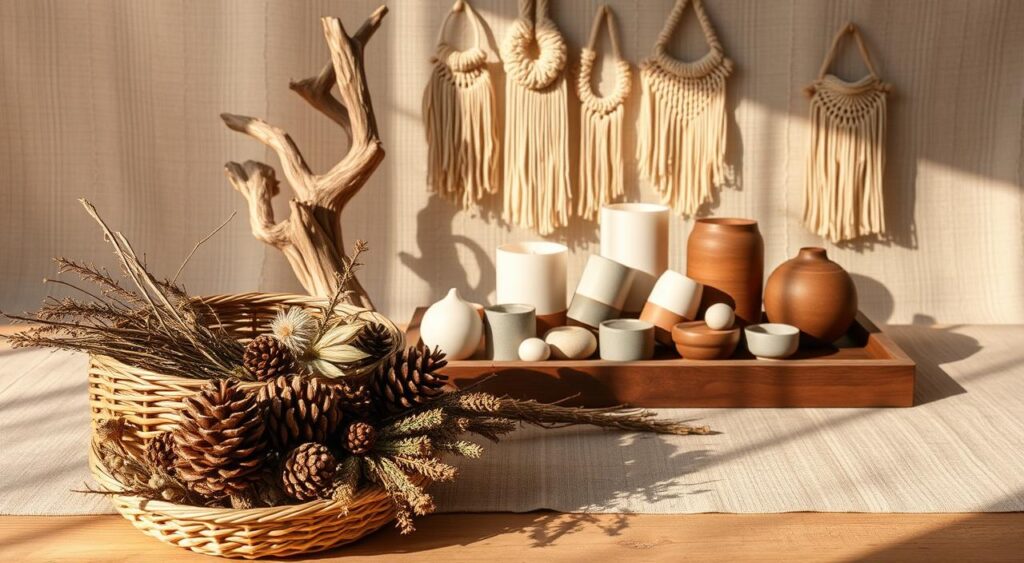
Transform your space with your own hands! Whether you’re a beginner or an experienced crafter, DIY projects let you turn nature’s gifts into rustic home accents and organic decor ideas. Let’s dive into creative ways to repurpose foraged items and old materials into stunning decor. Need inspiration? Check out these 10 easy ideas to get started.
Nature-Inpsired Wall Art & Installations
Hang foraged branches painted with eco-friendly stains to create wall art that feels wild and intentional. Driftwood centerpieces or moss-covered frames add texture without breaking the bank. Try these quick wins:
- Make a moss wall with preserved moss and a simple frame—perfect for small spaces.
- Frame pressed flowers or dried leaves for a gallery wall that celebrates seasonal changes.
- Use twine and driftwood to build wall-mounted shelves for plants or trinkets.
Handcrafted Containers & Storage
Turn scraps into showstoppers! Repurpose jars, baskets, or even old doors into storage solutions. Here’s how:
- Paint mismatched jars with earthy tones for a rustic vignette.
- Weave willow branches into baskets for a woven storage upgrade.
- Wrap a thrifted vase with jute rope for instant organic decor ideas.
Botanical Crafts & Dyeing
Get creative with nature’s colors! Experiment with:
- Leaf-printedig fabric by boiling leaves in water and ironing them onto cotton.
- Dye yarn or fabric with onion skins, berries, or coffee for rich, earthy hues.
- Create pressed-flower coasters using resin and scrap wood.
| Project | Materials | Skill Level |
|---|---|---|
| Moss Ball Bowl | Moss, bowl, glue | Beginner |
| Driftwood Picture Frame | Driftwood pieces, glue, screws | Beginner |
| Pressed-Flower Lampshade | Lampshade, flowers, adhesive | Intermediate |
| Twine-Wrapped Vase | Vase, twine, glue | Beginner |
Every project here uses what you already have—or can find outside!—so you won’t break the bank. Your home will shine with personal flair and the soul of nature. What are you waiting for? Grab a basket and start foraging!
Maintaining and Preserving Your Natural Decor Elements
Want your eco-friendly interior design to stay vibrant? Let’s explore care routines that keep sustainable home decor thriving. Proper maintenance isn’t just about longevity—it’s about honoring the craftsmanship and environmental ethos behind these materials.
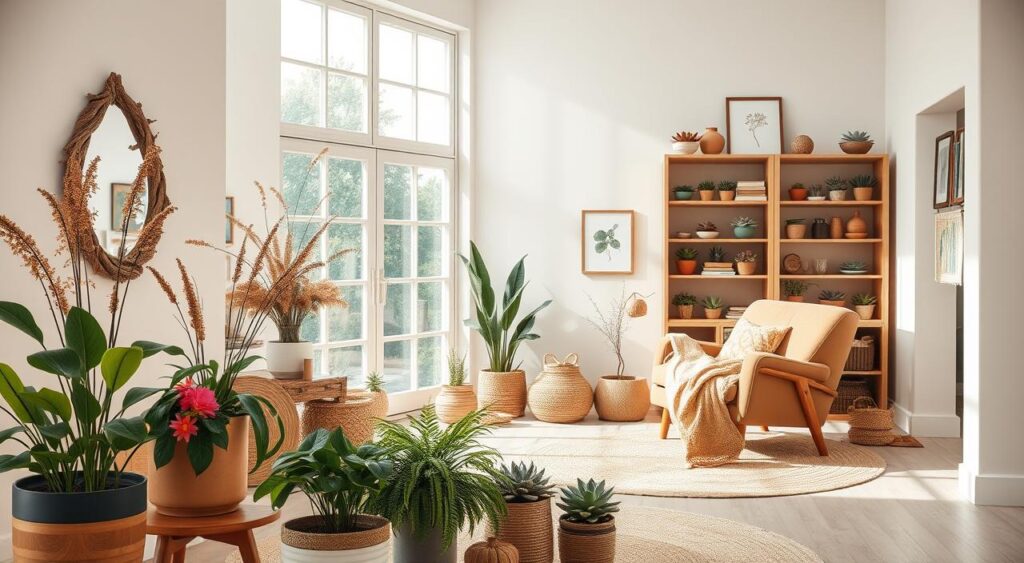
- Wood & Stone: Dust weekly with a dry cloth. For stains, mix baking soda and water—no harsh chemicals! Reclaimed wood items can be treated with food-grade mineral oil annually.
- Textiles: Opt for low-VOC cleaners. Wool rugs? Air them outdoors monthly to refresh fibers. Linen curtains? Spot-clean with cold water—never wring!
- Living Plants: Rotate pots monthly for even growth. Moss walls? Mist weekly and avoid direct AC blasts. Need humidity? Place a tray of pebbles and water nearby.
| Material | Care Tip |
|---|---|
| Driftwood decor | Store in dry areas to prevent warping |
| Preserved flowers | Avoid touching petals—dust with a soft makeup brush |
| Handwoven baskets | Hang in low-humidity zones to prevent mildew |
Pro tip: Invest in Greenguard Gold-certified cleaners—they’re safe for both your home and the planet. For textiles, look for Oeko-Tex 100 certified fabrics that resist fading. And remember—minor patina on wood or slight color shifts in textiles aren’t flaws. They’re proof your decor is aging gracefully, not failing.
By choosing eco-friendly care methods, you’re deepening your commitment to sustainable home decor. Every small action—from swapping to LED bulbs (which last 25x longer!) to repurposing thrifted furniture—adds up. Let’s keep those natural elements thriving, not just for today, but for the next generation’s homes too. 🌱
Conclusion: Creating Your Personalized Natural Sanctuary
Every home should mirror your unique connection to nature. Whether you prefer the tranquility of forest greens or the freshness of coastal blues, your space should resonate with your essence. Nature-inspired design is about creating a sanctuary that uplifts your mood and bridges you to the outdoors. Begin by selecting materials that resonate with you, such as warm wood, textured jute, or smooth stone. Incorporate personal elements like travel photos in driftwood frames or blankets with your favorite landscapes.
Biophilic home decor transcends mere plants and paint; it’s a philosophy. Introduce soft lighting, like linen-shaded lamps, to create a warm ambiance. Combine terracotta pots with woven baskets, and add a few low-maintenance succulents to bring life to corners. Even small decisions, like a sisal rug or a hand-carved wooden shelf, can ground your space in nature. Remember, harmony is essential. Allow your style to evolve as you discover new preferences, such as a handwoven throw from The Avenue or a macramé hanger with trailing vines.
Embrace simplicity. Clear out clutter, allow sunlight to illuminate your space, and arrange areas that encourage relaxation and happiness. Your sanctuary is dynamic, evolving with you. Each decision, from a sea-glass vase to a wool throw, imbues your home with deeper meaning. By merging functionality with purpose, you’ll create a space that nourishes both your soul and aesthetic. The essence of a natural sanctuary is its vitality, mirroring the dynamic world we inhabit.
FAQ
What are the benefits of decorating with natural materials?
Decorating with natural materials boosts sustainability and well-being. It reduces stress and enhances mood by connecting us to nature. The organic textures also create a serene environment, making us feel grounded.
How can I find sustainable decor options?
Seek out certified materials like FSC for wood and GOTS for textiles. Visit local artisan markets or vintage shops for unique items. Also, ask suppliers about their sourcing practices to ensure eco-friendly choices.
What types of plants are best for indoor decoration?
Begin with low-maintenance plants like snake plants, pothos, or zz plants. They adapt to various conditions and need little care. This makes them ideal for those new to adding greenery to their space.
How do I incorporate stone elements without overwhelming my space?
Use smaller stone accents like coasters, decorative objects, or bookends. These subtle touches add natural beauty without overwhelming your space. They ground your decor without the bulk of larger installations.
Can I mix modern furniture with natural materials?
Absolutely! Combining contemporary lines with organic textures creates a unique balance. Pair sleek furniture with wooden accents or soft textiles. This maintains a modern yet inviting atmosphere.
What are some easy DIY projects for natural decor?
You can make stunning wall art with foraged branches or pressed flowers. Upcycling containers with natural finishes or botanical printing also yields beautiful, personalized pieces. These projects enrich your home.
How can I ensure my natural decor lasts long-term?
Regular maintenance is essential! Use gentle cleaning methods for each material. Follow care instructions for textiles, and give wood and stone specific attention to prevent damage.
How can I make my home feel seasonal with natural decor?
Begin with a neutral color base and add seasonal elements. Use lighter woods and fresh botanicals in spring, and richer tones and textured layers in fall. This keeps your space fresh and connected to nature’s cycles.
